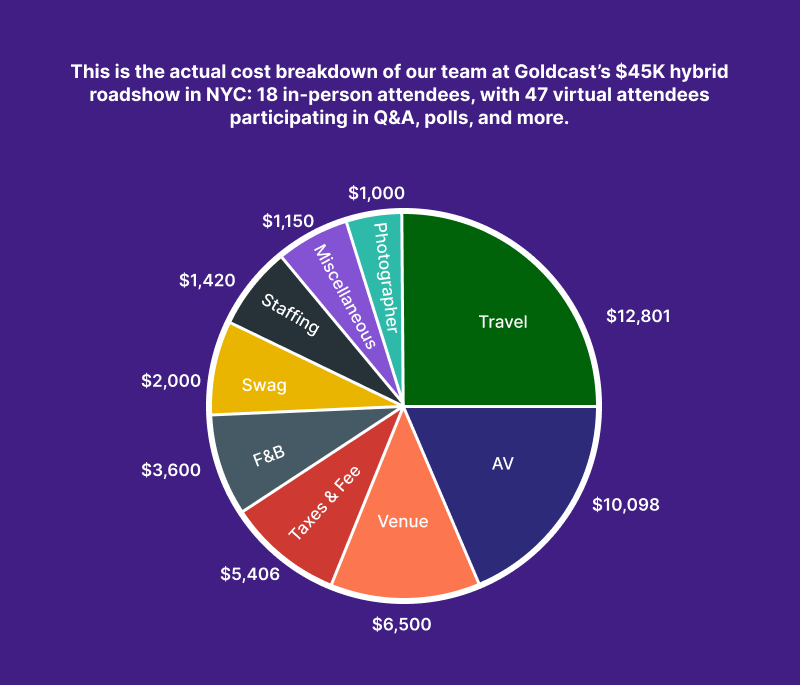Entering the New Era of Events: Lessons Learned from 6 High-Growth CMOs

Maximize Your Marketing ROI
Join 10,000 other marketers already getting the best tips on running engaging events that boost pipeline and create raving fans.
Every Chief Marketing Officer (CMO) you meet will have their own event marketing playbook — and yet, no two will look the same.
At Goldcast, if we’ve learned anything from our hundreds of deep dives with senior B2B marketing leaders, it’s that CMOs are constantly updating their event strategies to reflect what’s happening in the world and the impact on prospects, customers, and attendees.
Now that we’ve reached a moment in marketing when returning to in-person events is once again an option, we wanted to know exactly what types of events high-growth CMOs are thinking about as we move toward finding a new balance between digital and in-person experiences.
Because while the desire to meet, shake hands, and exchange knowledge face-to-face is always going to be there — many of our friends in the CMO community are skipping the trade show circuit in favor of a more balanced event marketing diet. Here’s what we’ve learned so far.
Budget constraints mean digital is still essential
A recent Goldcast survey revealed that 66% of companies are cutting travel budgets, while 80% are encouraging employees to attend virtual or hybrid events in lieu of large in-person engagements. This aligns with Deloitte's research that predicted a slow return to corporate travel. Despite many teams hoping for a full return to in-person, it’s clear that travel budgets and expectations simply aren’t what they used to be.
While we’re all eager to get back to meeting face-to-face, leading CMOs like Iterable’s Adriana Gil Miner believes that maintaining a digital presence while actively planning ways to take your event strategy hybrid is key to widening your reach and making every dollar count.
“We are definitely seeing a lot of big companies limiting travel expenses,” she explained to us in a recent episode of CMO Diaries. “I think it's important to have a combination of things in your portfolio — have your branded event but make it hybrid, make it accessible. Nothing can substitute that in-person experience. But of course, you then don't get the reach that you do with digital.”
For every marketer that has to keep their eyes on both budget and pipeline, the future of event marketing is about striking the right balance using all the available tools at your disposal.
“At this stage, it would be really foolish to focus on just one — it's more important to center on the person you serve, the target, the human being you’re trying to engage and what their journey needs to look like.”
Large digital events + regional roadshows = the new norm
Cutbacks combined with time out of office and increased likelihood of getting sick, means companies are understandably hesitant to send employees to large-scale, multi-day events.
Of course, we’re not saying CMOs should scrap trade shows completely. But this does mean the scale, location, and setup of high-volume events may see quite a change. The biggest trend we’re spotting?
Marketing leaders are now embracing event strategies that involve one large digital event (with a one-day time commitment max.), supplemented by smaller regionalized in-person roadshows.
Isabelle Guis, CMO at Commvault, articulated this shift perfectly when we sat down with her for a recent CMO Diaries interview.
Isabelle isn’t the only CMO we spoke to who’s focused on creating a more diversified and balanced approach to modern event marketing. Many B2B marketing leaders have a similar mindset as we move into the new year.
Let’s take a closer look at the reasons this approach makes sense moving forward.
Risk mitigation: Attendees don’t want to put all of their eggs in one basket — or all of their budget into one big event. For Isabelle, opting for one large-scale digital event, amplified by a targeted roadshow tour, limits that risk. She can keep the in-person connection, while also extending her reach and engagement with prospects digitally.
Hybrid is here to stay:Adriana from Iterable said it best: “Hybrid is not going to go away — we have been doing a combination lately: hybrid, virtual, and smaller field events. You can't rely on one particular mode of reaching out to customers, you need a combination of these three things.”
Personalization pays off: According to Drift CMO Katie Foote, smaller events create space for an added personal touch that large-scale events can’t always deliver. “I don't think you'll see any volume events. Because of the current macro environment, we'll likely see more roadshows, events that may be smaller and more intimate, and some type of field marketing or closing dinner. We hosted people at the US Open in Boston this past week, and those smaller events can have more personalized touches.”
Stream where you can: For Efrat Ravid, CMO at Quantum Metric, embracing a hybrid approach exposed her team to a whole new demand generation tool — live streaming. “I think hybrid will stay for a long time. Sometimes we need face-to-face, but if your prospects cannot travel, why not still give them access?”
Efrat and her team successfully live-streamed their Austin-based Quantum LEAP event to thousands of people last February. But to make sure this strategy doesn’t end up being just another waste of marketing dollars, CMOs are also finding new ways to integrate digital event elements to fuel account-based marketing (ABM) and increase personal connections with prospects and customers.
For Demandbase CMO John Miller, that’s where crafting personalized outreach moments at smaller events really does pay off — especially if you’re able to get creative with ways to make attendees feel special.In his case, that came with the added perk of being able to attribute revenue dollars to bobbleheads (yes, really).
“We picked 50 attendees who we really wanted to engage with, and we made personalized bobbleheads for each one,” John explained. “Then we sent them a note saying, ‘Hey, come by our booth to pick up your bobblehead.’ The ones that didn't come by, we then mailed it to them. We closed a deal a couple of months ago, and the guy specifically told the sales team that this deal happened because of that bobblehead — that was how we got on his radar.”
The beauty of combining these approaches is in the cohesive online and offline experience they create. If you’re considering a high-touch hybrid roadshow approach for your forward planning, you can access our transparent cost breakdown below as a benchmark to help you get started.

Partnership events are a budget-friendly alternative
As events shift from expensive trade shows to a more diversified mix of formats, we’re seeing CMOs tap into the power of their partner networks to increase their outcomes.
Rather than losing the majority of the marketing budget to expensive trade show sponsorships, CMOs are combining forces to plan, market, and execute events that drive both attendee numbers and engagement.
For experts like Isabelle, partnership events are all about the compound effect of creating that community.
“When your budget is limited, use your employees, partners, and customers for a multiplier effect,” she explained. “They can all be advocates. Let them see the strategy, send them branded swag, and ensure they understand what this year is going to be about. When we communicate, we send everything internally, and then we'll tell our partners and customers.”
Data-driven event programs are on the rise
Clearly, a shift away from large travel budgets and pricey trade shows isn’t just imminent — it’s already underway.
Because while trade shows still have their place in the modern marketing strategy, we’ve now turned another corner in the world of B2B events. Digital and hybrid event strategies offer deeper insights, fewer risks, and higher return on investment (ROI).
With ABM platforms like 6sense, DemandBase, and Terminus in the mix (to name a few), B2B marketers can track key intent signals like website visits, content consumed, number of relevant searches, and more. Like never before, marketers now have a real understanding of a prospect’s intent — one that goes way deeper than swapping business cards over a two-minute trade show meet-and-greet.
If there’s one thing the CMOs we spoke with all seem to agree on, it’s the idea of using these data insights to build the right event experiences for the right audiences.
“From a marketing perspective, you have to ask, ‘Which elements do I create with a global mindset and which are locally driven, and what's that mix? People miss in-person events, so we definitely have a mix,” said Talkdesk CMO Kathie Johnson. “We have started some in-person events, and as we go into this year, our prospects will see a combination of both those and digital because I think each has its own role.”
Prospects first, format second
Not every prospect or customer will have the time, budget, or inclination to travel. But equally, not every prospect will be satisfied with a purely digital connection.
More than your choice of in-person, hybrid, or digital event format, your audience is your most important guide on the road to building a resilient event strategy. By adjusting your strategy to deliver on your prospects’ real needs and motivations, you’ll be ready to execute a high-ROI event strategy that can thrive in any market.

Stay In Touch
Platform
Resources
Company
Community
© 2025 Copyright Goldcast, Inc. All rights reserved.



 Upcoming Events
Upcoming Events Event Series
Event Series On-Demand Events
On-Demand Events

